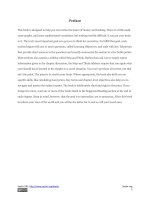Money and Banking: Lecture 13
Bạn đang xem bản rút gọn của tài liệu. Xem và tải ngay bản đầy đủ của tài liệu tại đây (420.42 KB, 24 trang )
Money and
Banking
Lecture 13
Review of the Previous Lecture
• Risk
• Characteristics
• Measurement
• Sources
• Reducing Risk
• Hedging
• Spreading
Topics Under Discussion
• Bond & Bond pricing
•
•
•
•
Zero Coupon Bond
Fixed Payment Loan
Coupon Bonds
Consols
• Bond Yield
• Yield to Maturity
• Current Yield
Bonds
• Virtually any financial arrangement involving the
current transfer of resources from a lender to a
borrower, with a transfer back at some time in
the future, is a form of bond.
• Car loans, home mortgages, even credit card
balances all create a loan from a financial
intermediary to an individual making a purchase
• Governments and large corporations sell bonds when
they need to borrow
Bonds
• The ease with which individuals,
corporations, and governments borrow is
essential to the functioning of our
economic system.
• Without this free flow of resources through
the bond markets, the economy would
grind to a halt.
• Historically, we can trace the concept of
using bonds to borrow to monarchs' almost
insatiable appetite for resources.
Bonds
• The Dutch invented modern bonds to
finance their lengthy war of independence
• The British refined the use of bonds to
finance government activities.
• The practice was soon popular among
other countries
Bonds
• A standard bond specifies the fixed
amount to be paid and the exact dates of
the payments
• How much should you be paying for a
bond?
• The answer depends on bond’s
characteristics
Bond Prices
•
Zero-coupon bonds,
•
•
promise a single future payment, such as a Treasury Bill.
Fixed payment loans,
•
•
•
conventional mortgages.
Car loans
Coupon Bonds,
•
•
•
make periodic interest payments and repay the principal at
maturity.
Treasury Bonds and most corporate bonds are coupon
bonds.
Consols,
•
make periodic interest payments forever, never repaying
the principal that was borrowed.
Zero-Coupon Bonds
• These are pure discount bonds since they
sell at a price below their face value
• The difference between the selling price
and the face value represents the interest
on the bond
• The price of such a bond, like a Treasury
bill (called “T-bill”), is the present value of
the future payment
Zero-Coupon Bonds
Price of a $100 face value zero-coupon bond
$100
n
(1 i)
Where
i is the interest rate in decimal form and
n is time until the payment is made in the
same time units as the interest rate
Zero-Coupon Bonds
• Given n, the price of a bond and the
interest rate move in opposite directions
• The most common maturity of a T-bill is 6
months; the Treasury does not issue them
with a maturity greater than 1 year
• The shorter the time until the payment is
made the higher the price of the bond, so
6 month T-bills have a higher price that a
one-year T-bill
Zero-Coupon Bonds
Examples. Assume i=4%
Price of a One-Year Treasury Bill.
100
(1 0.04)
$96.15
Price of a Six-Month Treasury Bill
100
(1 0.04)1 / 2
$98.06
Zero-Coupon Bonds
• The interest rate and the price for the T-bill
move inversely.
• If we know the face value and the price
then we can solve for the interest rate
Fixed Payment Loans
• they promise a fixed number of equal
payments at regular intervals
• Home mortgages and car loans are examples
of fixed payment loans;
• These loans are amortized, meaning that
the borrower pays off the principal along
with the interest over the life of the loan.
• Each payment includes both interest and
some portion of the principal
• The price of the loan is the present value
of all the payments
Fixed Payment Loans
Value of a Fixed Payment Loan =
FixedPayment
(1 i)
FixedPayment
2
(1 i)
FixedPayment
(1 i)n
Coupon Bond
• The value of a coupon bond is the present
value of the periodic interest payments
plus the present value of the principal
repayment at maturity
PCB
CouponPayment
(1 i)1
CouponPayment
(1 i) 2
......
CouponPayment
(1 i) n
FaceValue
(1 i ) n
• The latter part, the repayment of the
principal, is just like a zero-coupon bond
Consols
• A consol offers only periodic interest
payments; the borrower never repays the
principal
• There are no privately issued consols
because only governments can credibly
promise to make payments forever
• The price of a consol is the present value of
all the future interest payments, which is a bit
complicated because there are an infinite
number of payments
PConsol
Yearly Coupon Payment
i
Bond Yields
• Now that we know how to price a bond
while interest rate is known; we now move
to other direction and calculate the interest
rate or return to an investor
• So combining information about the
promised payments with the price to obtain
what is called the yield – a measure of cost
of borrowing or reward for lending.
• Interest rate and yield are used
interchangeably
Yield To Maturity
• The most useful measure of the return on
holding a bond is called the yield to
maturity (YTM).
• This is the yield bondholders receive if
they hold the bond to its maturity when the
final principal payment is made
• It can be calculated from the present value
formula
Yield To Maturity
Price of One-Year 5 percent Coupon Bond =
$5
(1 i )
$100
(1 i )
• The value of i that solves this equation is
the yield to maturity
Yield To Maturity
•
•
•
If the price of the bond is $100, then the
yield to maturity equals the coupon rate.
Since the price rises as the yield falls,
when the price is above $100, the yield
to maturity must be below the coupon
rate.
Since the price falls as the yield rises,
when the price is below $100, the yield
to maturity must be above the coupon
rate.
Yield To Maturity
• Considering 5% coupon bond
• If YTM is 5% then price is
$5
$100
= $100
(1 .05 ) (1 .05 )
• If YTM is 4% then price is
$5
$100
= $100.96
(1 .04 ) (1 .04 )
• If YTM is 6% then price is
$5
$100
= $99.06
(1 .06 ) (1 .06 )
Yield To Maturity
• Generally
• If the yield to maturity equals the coupon rate,
the price of the bond is the same as its face
value.
• If the yield is greater than the coupon rate, the
price is lower;
• if the yield is below the coupon rate, the price
is greater
Summary
• Bond & Bond pricing
•
•
•
•
Zero Coupon Bond
Fixed Payment Loan
Coupon Bonds
Consols
• Bond Yield
• Yield to Maturity
• Current Yield









